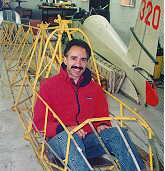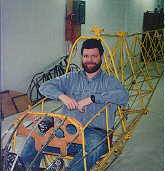 Jim Miceli
Jim Miceli
By Guy Byars
The restoration of the only factory built Schweizer SGU 1-20, S/N 1, NX 91840, has begun in Cincinnati OH by Guy Byars and Jim Miceli.
 Jim Miceli
Jim Miceli
 Guy Byars
Guy Byars
History
The 1-20 is very similar to the 1-19, except the wing, outboard of the strut attach points on the 1-20, is longer and tapered. The 1-20's wingspan is 43 ft vs. 36 ft for the 1-19. S/N 1, the factory prototype, was manufactured on 29-July-1946 and was the only 1-20 made by the Schweizer factory.
To my knowledge, two other 1-20s now exist. S/N 30A, N2708A, was made from a 1-19 kit in 1956 by Art Heavener. It is now in the Iowa Aviation Preservation Center's Museum in Greenfield Iowa. The other 1-20, S/N 37, N37HH, was produced by the factory as a 1-19 and later converted to a 1-20 in the 1950's. It is based near Minneapolis/St. Paul and owned by Roger Gomoll and 3 other partners.
If anyone has any additions or corrections to the above history, please contact me. Also I am very interested in any information anyone might have on S/N 1, especially early photographs showing paint schemes. I can be contacted at:
Guy Ford Byars
1333 Cryer Ave
Cincinnati OH 45208
(513)-871-2462
The Restoration Team
S/N 1 was recently purchased by myself and Jim Miceli of Dayton OH. My experience in restoration is limited. My father, Ed Byars, and I restored a J-3 Cub many years ago. Unfortunately, at the time I was more concerned with foolish teenage pursuits than aircraft restoration, so I didn't take full advantage of that great opportunity. On the positive side, I now have access to a wealth of restoration knowledge. My father recently completed a Waco UPF-7 restoration and is now working on a Cabin Waco. My friends, Bob & Harold Armstrong in Cumberland MD, are finishing up a 1-19 restoration. They have won several Oshkosh Grand Champion restoration awards and their work is second to none. Their research and experience with the 1-19 will be extremely valuable with our 1-20 work. John Molumphy, a long time friend living in Roanoke VA, is also restoring a 1-19. He had to built up two new wings from scratch and will be another excellent source. Closer to home are "Cuby" and Cathy Stuart in Waynesville OH. They have completely restored countless J-3 Cubs and are experts in airframe and fabric work. Cuby is an A/I and will be providing close supervision for the 1-20 restoration.
While my partner Jim has little experience in restoration work, he is the manager of a manufacturing machine shop and has the expertise and equipment to fabricate anything from metal. Also, the phrase "good enough" is not in his vocabulary. His work is either "done right" or it is "done again". I have seen his metal work and it is indeed perfect museum quality. In short, Jim is the ideal partner in a restoration project.
Both Jim and I are very enthusiastic about this project. It is a rare opportunity for us both to learn about aircraft restoration and to bring a very unique and beautiful glider back to flying condition.
Current Condition
There is much work to do. The glider was disassembled in the mid 1970's and the project has changed hands 4-5 times in the past 20 years. With each change of ownership, many of the smaller, but important, parts seemed to have vanished. Many replacement parts will have to be either fabricated by Jim, or replacements located and acquired by myself.
The fuselage is in fairly good shape, but will still require sandblasting, inspection, and replacement of several tubes. The tail surfaces and ailerons are all complete with only minor work needed. The wings, however, are another story. Two new wings will have to be made from scratch. While the project came with a set of ribs already built and some basic work done on the left wing, it is uncertain at this time whether that work can be used. Either way, there is much long hard, but interesting and exciting work ahead!
Road Trip!
We purchased the 1-20 from Lars Johannesen in Delaware. A wonderful man to be sure, but he had the unfortunate habit of frequently changing his mind about selling the glider. This was understandable because he loved that glider very much, no one can fault him for that, and it was difficult for him to give it up. Despite several false starts, he finally agreed to sell it to me.
Since my partner couldn't go with me to pick it up due to an important business trip, (where are his priorities?), I began looking for someone else who had trailer towing experience to help with the 11 hour drive each way. I immediately contacted Tracy Scheiman. She was the one who picked up the ASH-26E from the port in Delaware and towed it single handedly, though the worst blizzard of the winter, to Chicago for the 1994 SSA Convention.
Since the 1-20 didn't come with a trailer, we borrowed the Caesar Creek Soaring Club's enclosed Blanik trailer. Special thanks to CCSC for its support of the vintage sailplane movement by loaning us the trailer.
Monday March 28, 6:30 am. Tracy and I pull out of Waynesville destined for Wilmington Delaware. While we encountered nearly continuous rain all the way up, the trip was otherwise uneventful. My "new" 1987 Taurus Wagon did a super job of towing the cavernous Blanik trailer. It was a bit slow going up the hills in the mountains, but otherwise did great.
We arrived at Lars' house around 5:00 p.m. and immediately began the loading operation. It was still raining. The aircraft looked about as I had expected. We went into his basement to look at the wing he had just built. It too seemed OK, but then I looked at the only door from the basement to the outside and quickly became very concerned.
The exit from the basement was via a set of "storm stairs" leading outside. These stairs consist of two metal trap doors outside at ground level which lead down a set of very narrow, very steep stairs to a door in the basement. My thoughts went to those news stories about someone who builds a boat in their basement or garage, but had mistakenly built it too big to get it out the door. I didn't even want to think about it.
Sure enough, the wing he built in the basement was too big to get out the door. We tried it tip first, root first, trailing edge up, trailing edge down, slanted, angled, and every other possible combination we could think of. It was not coming out. After an hour and a half of frustration, Lars determined that if we took a saw and cut several of the ribs off, we could get enough clearance to get out. I resisted this suggestion for a very long time, but finally, after standing out in the rain holding a wing stuck in the basement stairs for over an hour, I gave up and said: "cut the damn things."
As Lars' friend approached with the saw, Tracy ran up and threw herself between the saw and the ribs.
"Cut if you must this young blond head, but spare these precious ribs." she said.
Well, she didn't really do that, what she did was say, "I'm NOT letting you cut those ribs!", and then gave us her idea on how to get the wing through the door. I pushed the man with the saw away from the rib in the nick of time and shouted "you heard her, now do it." We followed Tracy's directions and the wing came out easily. We are greatly in her debt.
The Blanik trailer accepted the 1-20 as easily as if it had been made for it. The extra room was great for loading all the various pieces of the project inside. When the loading was complete and we closed the trailer door, the rain, as if on command, stopped.
It was 7:00 p.m. as we said our good-byes to Lars and began the long drive back. I was hoping to spend the night in Cumberland MD at the home of Bob and Harold Armstrong. I very much wanted to closely examine and photograph their 1-19 project. However, since we passed through Cumberland at 1:30 am, and Tracy wanted to drive straight back, we kept going.
After Cumberland, Tracy was driving and I fell into a fitful sleep. I had several strange dreams. In one dream I was on the starship Enterprise watching the stars streak by at warp speed. Wait a minute, this wasn't a dream! Those aren't stars, they are large snowflakes streaking by in the headlight's glare! As we entered the high ground between Cumberland and Morgantown WV, we encountered heavy snow. At times the snow was so heavy, we had to slow to a crawl due to poor visibility. I nervously looked over at Tracy to see how she was doing. After her experience towing the ASH-26E in the Chicago Convention blizzard, these conditions were no problem for her and she guided us smoothly on.
It was strange weather indeed. When we went down into the valleys, we were in heavy rain, but as we climbed the ridges, the rain changed to heavy snow. I was very glad the 1-20 was protected in the enclosed trailer. Finally, at 3:00 am, we passed over Chestnut Ridge and descended into Morgantown leaving the high ground and snow behind us.
The rest of the trip was long and tiring, but uneventful. We arrived back in Waynesville at 8:00 am in bright sunshine and clear skies. I dropped Tracy off and headed to the Waynesville airport. I proudly opened the trailer door and showed my new glider to friend and mechanic, Rick Glass. After a long thoughtful look, he politely said, "Yup, it's a project." I replied, "Yes, but it's MY project! (excuse me Jim, OUR project).